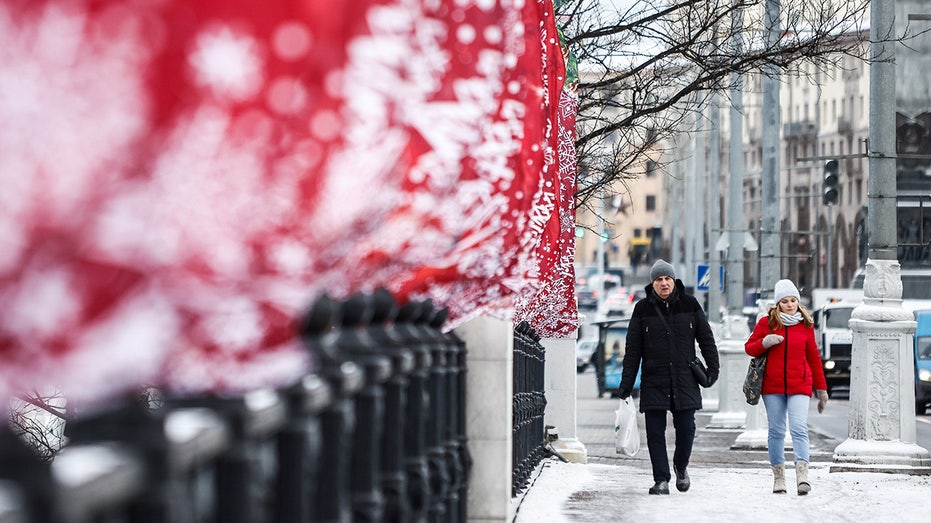Belarus Economy: What to Know
Belarus has been targeted by sanctions for its participation in Russia’s invasion of Ukraine
Protesters disrupt major trade route between Poland and Belarus
FOX Business' Ashley Webster reports from Poland on the protest held in an effort to halt trade with Russia.
Ukraine’s Ministry of Dense warned this week that there were signs suggesting the Belarusian military was preparing for a "direct invasion" of Ukraine as the conflict neared its fifth week.
Belarus, which lies just to the north of Ukraine, has been targeted by sanctions for its participation in Russia’s invasion of Ukraine. Russia stationed thousands of its troops in Belarus for military exercises weeks ahead of the Feb. 24 invasion.

People walk along a street in Minsk, Belarus December 20, 2021. (REUTERS/Maxim Shemetov)
As the world watches "White Russia" for its next moves, here are some things to know about Belarus and its economy.
Ruled by authoritarian President Alexander Lukashenko for nearly 30 years, Belarus has been dubbed "Europe’s last dictatorship" over accusations that he has engaged in public corruption.
The country gained independence from the Soviet Union in 1991. But unlike other former Soviet countries that grew closer to the west, Belarus has cultivated ties with Moscow, with some regarding it as a puppet regime.

Russian President Vladimir Putin, right, and Belarusian President Alexander Lukashenko pose for a photo during their meeting in Moscow, Russia, Friday, March 11, 2022. (Mikhail Klimentyev, Sputnik, Kremlin Pool Photo via AP)
Since independence, Belarus has pursued a gradual transition path, with limited structural reforms and a modest expansion of the private sector.
A 2022 index of economic freedom from the Heritage Foundation ranked Belarus as 45th in a list of 45 countries in the European region.
Belarus’ main industrial sectors include energy, agriculture and forestry, construction, and the services sector, which accounted for nearly half of the country’s GDP in 2019.
REP SMITH MOVES TO BLOCK CHINA FROM NORMAL TRADE RELATIONS WITH US
To be sure, the country’s trade in energy commodities has contributed to GDP growth and a reduction in poverty. The years 2003 to 2013 saw poverty levels decreasing and household income rise among the bottom 40%, according to the World Bank. Despite these modest improvements, however, average income remains lower than its regional peers.
Belarus’ population has been declining since the fall of the Soviet Union. In the earliest 1990s, the country reached a peak of more than 10.2 million people.
Today, the country has a population of fewer than 10 million people with a GDP of $60 billion – roughly on par with a small U.S. state like South Dakota or Rhode Island. Its GDP has since fallen from a high of nearly $80 billion in 2014.

Belarusian President Alexander Lukashenko chairs a meeting with military officials in Minsk, Belarus February 24, 2022. (Nikolay Petrov/BelTA/Handout via REUTERS)
Life expectancy, meanwhile, has improved significantly in the last 20 years. It began to decline after the fall of the Soviet Union, dropping from 71 in 1989 to 68 in 2002. Today the average life expectancy is around 74.
The economy’s strong exports in 2021 helped create a cyclical upturn, but the country’s economy is expected to take a hit in 2022 given its military’s collaboration with Russia in the invasion of Ukraine.
CLICK HERE TO READ FOX BUSINESS ON THE GO
In 2020, the country was beset by widespread protests over what many deemed a rigged election. The protests were met with a brutal crackdown and accusations from Lukashenko that the west had orchestrated the dissent.





















